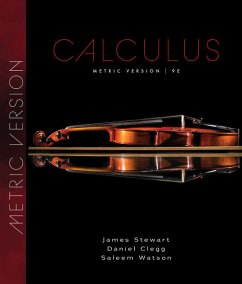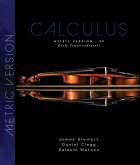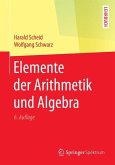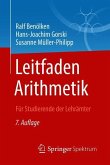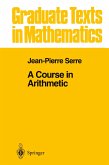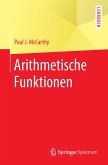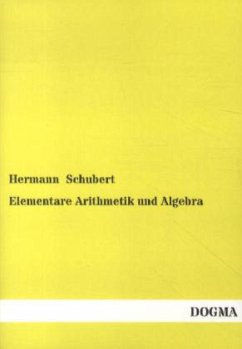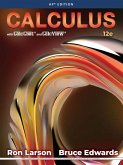- Gebundenes Buch
- Merkliste
- Auf die Merkliste
- Bewerten Bewerten
- Teilen
- Produkt teilen
- Produkterinnerung
- Produkterinnerung
CALCULUS, Metric, 9th Edition, provides you with the strongest foundation for a STEM future. James Stewart's Calculus, Metric series is the top-seller in the world because of its problem-solving focus, mathematical precision and accuracy, and outstanding examples and problem sets. Selected and mentored by Stewart, Daniel Clegg and Saleem Watson continue his legacy and their careful refinements retain Stewart's clarity of exposition and make the 9th Edition an even more usable learning tool. The accompanying WebAssign includes helpful learning support and new resources like Explore It…mehr
Andere Kunden interessierten sich auch für
![Calculus: Early Transcendentals, Metric Edition Calculus: Early Transcendentals, Metric Edition]() James StewartCalculus: Early Transcendentals, Metric Edition69,99 €
James StewartCalculus: Early Transcendentals, Metric Edition69,99 €![Elemente der Arithmetik und Algebra Elemente der Arithmetik und Algebra]() Harald ScheidElemente der Arithmetik und Algebra44,99 €
Harald ScheidElemente der Arithmetik und Algebra44,99 €![Leitfaden Arithmetik Leitfaden Arithmetik]() Ralf BenölkenLeitfaden Arithmetik34,99 €
Ralf BenölkenLeitfaden Arithmetik34,99 €![A Course in Arithmetic A Course in Arithmetic]() Jean-Pierre SerreA Course in Arithmetic46,99 €
Jean-Pierre SerreA Course in Arithmetic46,99 €![Arithmetische Funktionen Arithmetische Funktionen]() Paul J. McCarthyArithmetische Funktionen37,99 €
Paul J. McCarthyArithmetische Funktionen37,99 €![Elementare Arithmetik und Algebra Elementare Arithmetik und Algebra]() Hermann SchubertElementare Arithmetik und Algebra39,90 €
Hermann SchubertElementare Arithmetik und Algebra39,90 €![Calculus, AP Edition, 12e Calculus, AP Edition, 12e]() Ron LarsonCalculus, AP Edition, 12e231,99 €
Ron LarsonCalculus, AP Edition, 12e231,99 €-
-
-
CALCULUS, Metric, 9th Edition, provides you with the strongest foundation for a STEM future. James Stewart's Calculus, Metric series is the top-seller in the world because of its problem-solving focus, mathematical precision and accuracy, and outstanding examples and problem sets. Selected and mentored by Stewart, Daniel Clegg and Saleem Watson continue his legacy and their careful refinements retain Stewart's clarity of exposition and make the 9th Edition an even more usable learning tool. The accompanying WebAssign includes helpful learning support and new resources like Explore It interactive learning modules. Showing that Calculus is both practical and beautiful, the Stewart approach and WebAssign resources enhance understanding and build confidence for millions of students worldwide.
Produktdetails
- Produktdetails
- Verlag: Brooks Cole / Cengage Learning EMEA
- 9. Aufl.
- Seitenzahl: 1392
- Erscheinungstermin: 2. Juni 2020
- Englisch
- Abmessung: 258mm x 227mm x 50mm
- Gewicht: 2780g
- ISBN-13: 9780357113462
- ISBN-10: 0357113462
- Artikelnr.: 59563063
- Herstellerkennzeichnung
- Libri GmbH
- Europaallee 1
- 36244 Bad Hersfeld
- gpsr@libri.de
- Verlag: Brooks Cole / Cengage Learning EMEA
- 9. Aufl.
- Seitenzahl: 1392
- Erscheinungstermin: 2. Juni 2020
- Englisch
- Abmessung: 258mm x 227mm x 50mm
- Gewicht: 2780g
- ISBN-13: 9780357113462
- ISBN-10: 0357113462
- Artikelnr.: 59563063
- Herstellerkennzeichnung
- Libri GmbH
- Europaallee 1
- 36244 Bad Hersfeld
- gpsr@libri.de
Preface. To the Student. Diagnostic Tests. A Preview of Calculus. 1. FUNCTIONS AND LIMITS.Four Ways to Represent a Function. Mathematical Models: A Catalog of Essential Functions. New Functions from Old Functions. The Tangent and Velocity Problems. The Limit of a Function. Calculating Limits Using the Limit Laws. The Precise Definition of a Limit. Continuity. Review. Principles of Problem Solving. 2. DERIVATIVES. Derivatives and Rates of Change. Writing Project: Early Methods for Finding Tangents. The Derivative as a Function. Differentiation Formulas. Applied Project: Building a Better Roller Coaster. Derivatives of Trigonometric Functions. The Chain Rule. Applied Project: Where Should a Pilot Start Descent? Implicit Differentiation. Discovery Project: Families of Implicit Curves. Rates of Change in the Natural and Social Sciences. Related Rates. Linear Approximations and Differentials. Discovery Project: Polynomial Approximations. Review. Problems Plus.3. APPLICATIONS OF DIFFERENTIATION.Maximum and Minimum Values. Applied Project: The Calculus of Rainbows. The Mean Value Theorem. What Derivatives Tell Us About the Shape of a Graph. Limits at Infinity; Horizontal Asymptotes. Summary of Curve Sketching. Graphing with Calculus and Technology. Optimization Problems. Applied Project: The Shape of a Can. Applied Project: Planes and Birds: Minimizing Energy. Newton's Method. Antiderivatives. Review. Problems Plus. 4. INTEGRALS. The Area and Distance Problems. The Definite Integral. Discovery Project: Area Functions. The Fundamental Theorem of Calculus. Indefinite Integrals and the Net Change Theorem. Writing Project: Newton, Leibniz, and the Invention of Calculus. The Substitution Rule. Review. Problems Plus.5. APPLICATIONS OF INTEGRATION.Areas Between Curves. Applied Project: The Gini Index. Volumes. Volumes by Cylindrical Shells. Work. Average Value of a Function. Applied Project: Calculus and Baseball. Review. Problems Plus.6. INVERSE FUNCTIONS: EXPONENTIAL, LOGARITHMIC, AND INVERSE TRIGONOMETRIC FUNCTIONS.Inverse Functions. Instructors may cover either Sections 6.2-6.4 or Sections 6.2*-6.4*. Exponential Functions and Their Derivatives. Logarithmic Functions. Derivatives of Logarithmic Functions. The Natural Logarithmic Function. The Natural Exponential Function. General Logarithmic and Exponential Functions. Exponential Growth and Decay. Applied Project: Controlling Red Blood Cell Loss During Surgery. Inverse Trigonometric Functions. Applied Project: Where to Sit at the Movies. Hyperbolic Functions. Indeterminate Forms and l'Hospital's Rule. Writing Project: The Origins of l'Hospital's Rule. Review. Problems Plus. 7. TECHNIQUES OF INTEGRATION.Integration by Parts. Trigonometric Integrals. Trigonometric Substitution. Integration of Rational Functions by Partial Fractions. Strategy for Integration. Integration Using Tables and Technology. Discovery Project: Patterns in Integrals. Approximate Integration. Improper Integrals. Review. Problems Plus.8. FURTHER APPLICATIONS OF INTEGRATION. Arc Length. Discovery Project: Arc Length Contest. Area of a Surface of Revolution. Discovery Project: Rotating on a Slant. Applications to Physics and Engineering. Discovery Project: Complementary Coffee Cups. Applications to Economics and Biology. Probability. Review. Problems Plus.9. DIFFERENTIAL EQUATIONS. Modeling with Differential Equations. Direction Fields and Euler's Method. Separable Equations. Applied Project: How Fast Does a Tank Drain? Models for Population Growth. Linear Equations. Applied Project: Which Is Faster, Going Up or Coming Down? Predator-Prey Systems. Review. Problems Plus.10. PARAMETRIC EQUATIONS AND POLAR COORDINATES. Curves Defined by Parametric Equations. Discovery Project: Running Circles Around Circles. Calculus with Parametric Curves. Discovery Project: Bézier Curves. Polar Coordinates. Discovery Project: Families of Polar Curves. Calculus in Polar Coordinates. Conic Sections. Conic Sections
Preface. To the Student. Diagnostic Tests. A Preview of Calculus. 1. FUNCTIONS AND LIMITS.Four Ways to Represent a Function. Mathematical Models: A Catalog of Essential Functions. New Functions from Old Functions. The Tangent and Velocity Problems. The Limit of a Function. Calculating Limits Using the Limit Laws. The Precise Definition of a Limit. Continuity. Review. Principles of Problem Solving. 2. DERIVATIVES. Derivatives and Rates of Change. Writing Project: Early Methods for Finding Tangents. The Derivative as a Function. Differentiation Formulas. Applied Project: Building a Better Roller Coaster. Derivatives of Trigonometric Functions. The Chain Rule. Applied Project: Where Should a Pilot Start Descent? Implicit Differentiation. Discovery Project: Families of Implicit Curves. Rates of Change in the Natural and Social Sciences. Related Rates. Linear Approximations and Differentials. Discovery Project: Polynomial Approximations. Review. Problems Plus.3. APPLICATIONS OF DIFFERENTIATION.Maximum and Minimum Values. Applied Project: The Calculus of Rainbows. The Mean Value Theorem. What Derivatives Tell Us About the Shape of a Graph. Limits at Infinity; Horizontal Asymptotes. Summary of Curve Sketching. Graphing with Calculus and Technology. Optimization Problems. Applied Project: The Shape of a Can. Applied Project: Planes and Birds: Minimizing Energy. Newton's Method. Antiderivatives. Review. Problems Plus. 4. INTEGRALS. The Area and Distance Problems. The Definite Integral. Discovery Project: Area Functions. The Fundamental Theorem of Calculus. Indefinite Integrals and the Net Change Theorem. Writing Project: Newton, Leibniz, and the Invention of Calculus. The Substitution Rule. Review. Problems Plus.5. APPLICATIONS OF INTEGRATION.Areas Between Curves. Applied Project: The Gini Index. Volumes. Volumes by Cylindrical Shells. Work. Average Value of a Function. Applied Project: Calculus and Baseball. Review. Problems Plus.6. INVERSE FUNCTIONS: EXPONENTIAL, LOGARITHMIC, AND INVERSE TRIGONOMETRIC FUNCTIONS.Inverse Functions. Instructors may cover either Sections 6.2-6.4 or Sections 6.2*-6.4*. Exponential Functions and Their Derivatives. Logarithmic Functions. Derivatives of Logarithmic Functions. The Natural Logarithmic Function. The Natural Exponential Function. General Logarithmic and Exponential Functions. Exponential Growth and Decay. Applied Project: Controlling Red Blood Cell Loss During Surgery. Inverse Trigonometric Functions. Applied Project: Where to Sit at the Movies. Hyperbolic Functions. Indeterminate Forms and l'Hospital's Rule. Writing Project: The Origins of l'Hospital's Rule. Review. Problems Plus. 7. TECHNIQUES OF INTEGRATION.Integration by Parts. Trigonometric Integrals. Trigonometric Substitution. Integration of Rational Functions by Partial Fractions. Strategy for Integration. Integration Using Tables and Technology. Discovery Project: Patterns in Integrals. Approximate Integration. Improper Integrals. Review. Problems Plus.8. FURTHER APPLICATIONS OF INTEGRATION. Arc Length. Discovery Project: Arc Length Contest. Area of a Surface of Revolution. Discovery Project: Rotating on a Slant. Applications to Physics and Engineering. Discovery Project: Complementary Coffee Cups. Applications to Economics and Biology. Probability. Review. Problems Plus.9. DIFFERENTIAL EQUATIONS. Modeling with Differential Equations. Direction Fields and Euler's Method. Separable Equations. Applied Project: How Fast Does a Tank Drain? Models for Population Growth. Linear Equations. Applied Project: Which Is Faster, Going Up or Coming Down? Predator-Prey Systems. Review. Problems Plus.10. PARAMETRIC EQUATIONS AND POLAR COORDINATES. Curves Defined by Parametric Equations. Discovery Project: Running Circles Around Circles. Calculus with Parametric Curves. Discovery Project: Bézier Curves. Polar Coordinates. Discovery Project: Families of Polar Curves. Calculus in Polar Coordinates. Conic Sections. Conic Sections

